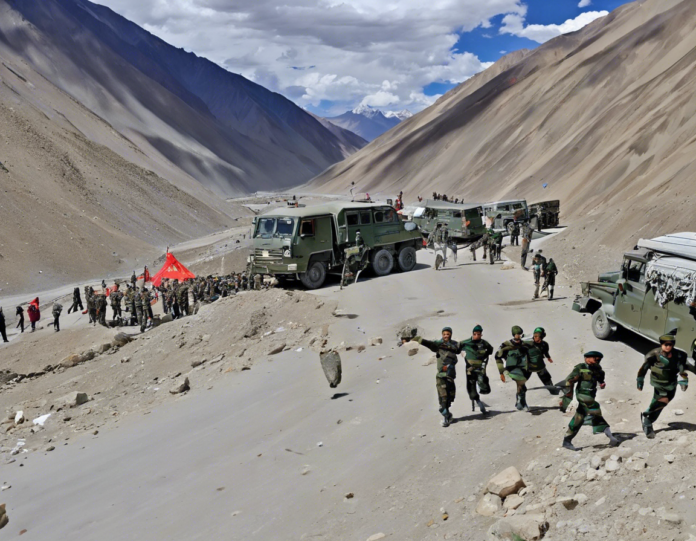Introduction
In the remote and rugged terrains of Ladakh, a haven for adventure seekers and a strategic military outpost for India, tragedy struck a small army unit stationed in the region. The Leh Ladakh Army outpost, nestled amidst the snow-clad mountains, faced a devastating avalanche that claimed the lives of several soldiers and left the nation mourning the loss of its brave warriors. This tragic incident sheds light on the challenging conditions faced by the Indian Army in such high-altitude regions and the heroic sacrifices made by the soldiers in service to their country.
The Leh Ladakh Army Outpost: A Strategic Post in the Himalayas
Nestled in the Himalayan region of Ladakh, the Leh Ladakh Army outpost serves as a crucial strategic location for the Indian Army. Situated at a high altitude of over 11,000 feet above sea level, the outpost plays a pivotal role in safeguarding the borders in this sensitive area. It serves as a vital surveillance point, monitoring activities along the Line of Control (LoC) with neighboring countries. The harsh climatic conditions and rugged terrain make it a challenging posting for the soldiers stationed there, requiring them to display exceptional grit, determination, and resilience in carrying out their duties.
The Devastating Avalanche: Nature’s Wrath Unleashed
In a cruel twist of fate, the Leh Ladakh Army outpost was struck by a massive avalanche, burying several soldiers under tons of snow and ice. The sudden and ferocious nature of avalanches makes them one of the most deadly natural disasters in mountainous regions. Despite the best efforts of the army personnel to rescue their comrades, the relentless force of the avalanche proved overwhelming, leading to tragic losses. The incident serves as a stark reminder of the perils faced by the soldiers in such extreme environments and the inherent risks associated with their line of duty.
The Heroic Sacrifice: Honoring the Fallen Soldiers
As news of the avalanche spread, the nation mourned the loss of its brave soldiers who made the ultimate sacrifice in the line of duty. Their selfless dedication to protecting the sovereignty of the nation and ensuring the safety of its citizens exemplifies the epitome of courage and valor. The heroic sacrifice of these soldiers serves as a poignant reminder of the untold sacrifices made by the armed forces in safeguarding the country’s borders and defending its honor. Their names will be etched in the annals of history as martyrs who laid down their lives for a greater cause.
Lessons Learned and Moving Forward: Strengthening Preparedness and Resilience
In the aftermath of the tragedy, it becomes imperative to reflect on the lessons learned and bolster our preparedness and resilience in the face of such natural calamities. The Indian Army must evaluate its existing protocols for handling emergencies in high-altitude regions and enhance its disaster response mechanisms to mitigate risks effectively. Training programs focusing on avalanche safety and rescue operations need to be intensified to equip the soldiers with the necessary skills and knowledge to navigate these treacherous terrains.
Frequently Asked Questions (FAQs)
Q1: What causes avalanches in mountainous regions like Ladakh?
A1: Avalanches are triggered by a combination of factors, including snowfall, temperature fluctuations, slope steepness, and snowpack instability. The release of accumulated snow can result in a cascading flow of snow and ice down the mountainside, posing a significant threat to anyone in its path.
Q2: How do soldiers stationed in high-altitude outposts prepare for avalanches?
A2: Soldiers undergo specialized training in avalanche safety, including recognizing warning signs, using rescue equipment such as probes and beacons, establishing communication protocols, and practicing effective rescue techniques. They are also trained to assess the terrain for potential avalanche risks and take precautionary measures to minimize the danger.
Q3: What role do climate change and global warming play in increasing the risk of avalanches in mountainous regions?
A3: Climate change can contribute to the destabilization of snowpacks due to rising temperatures, irregular precipitation patterns, and altering snow densities. These factors can increase the frequency and intensity of avalanches in mountainous regions, posing a greater threat to human populations and infrastructure.
Q4: How does the Indian Army support the families of soldiers who lose their lives in the line of duty?
A4: The Indian Army has well-established mechanisms to provide financial assistance, emotional support, and other benefits to the families of soldiers who make the supreme sacrifice. This includes monetary compensation, pension benefits, educational support for children, and housing assistance to ensure the well-being of the bereaved families.
Q5: What measures can be taken to enhance the safety and security of army personnel in high-altitude outposts like Leh Ladakh?
A5: Implementing advanced early warning systems for avalanches, conducting regular risk assessments of avalanche-prone areas, providing specialized training in mountain warfare and disaster management, equipping soldiers with state-of-the-art rescue gear, and ensuring robust communication networks are essential steps to enhance the safety and security of army personnel in high-altitude outposts.
Conclusion
The tragic incident at the Leh Ladakh Army outpost serves as a somber reminder of the challenges and risks faced by soldiers in safeguarding the nation’s borders in inhospitable terrains. It underscores the need for continuous preparedness, training, and support mechanisms to ensure the safety and well-being of our armed forces personnel deployed in such hazardous environments. As a nation, it is our solemn duty to honor the memory of the fallen soldiers and strengthen our resolve to protect the defenders of our country who stand guard on the frontlines, facing nature’s fury and human adversaries with unwavering courage and dedication.





